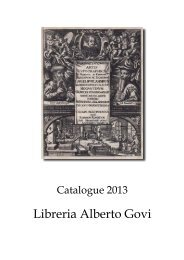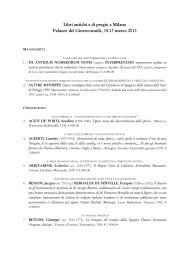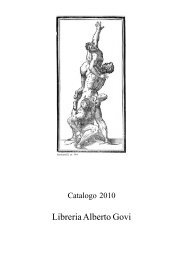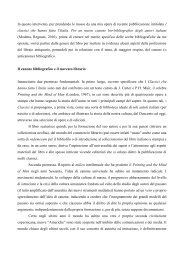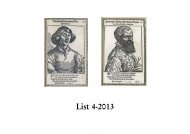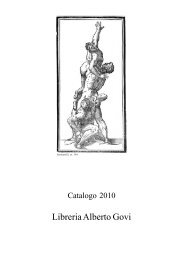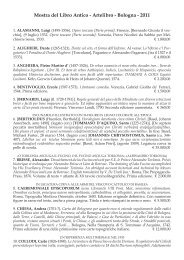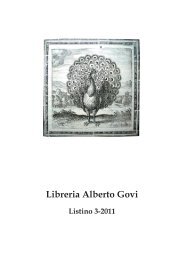List 1-2013.pdf - Libreria Antiquaria Alberto Govi
List 1-2013.pdf - Libreria Antiquaria Alberto Govi
List 1-2013.pdf - Libreria Antiquaria Alberto Govi
Create successful ePaper yourself
Turn your PDF publications into a flip-book with our unique Google optimized e-Paper software.
w i t h a s p e e c h o n p a i n t i n g<br />
8. EQUICOLA, Mario (ca. 1470-1525). Institutioni... al comporre in ogni sorte di Rima della lingua volgare, con uno<br />
eruditissimo Discorso della Pittura, & con molte segrete allegorie circa le Muse & la Poesia. Milano, [Francesco Minizio<br />
Calvo], 1541.<br />
4to. (25) leaves (lacking the last blank). Title within a large ornamental border. Old vellum, a very light dampstain in the blank lower margins,<br />
otherwise a very fine copy from the libraries of Giuseppe Martini (with his pencil notes on the inner front cover and free endpaper)<br />
and of Sergio Colombi (with his bookplate).<br />
VERY RARE FIRST EDITION. Themes dear to Renaissance artists, such as the theory of<br />
color and the theory of proportion were already discussed in Libro de natura de amore (1525).<br />
However, Equicola did not grant figurative art a more illustrious place than that usually assigned<br />
to it by contemporary men of letters - a place well below that of literature. The Istitutioni<br />
makes this clear. But the fact that the work is also presented as ‘an erudite discourse on<br />
painting’ at the frontispiece suggests the increasing status of that art among educated readers.<br />
Written between 1508 and 1518, the Istitutioni open with a dedicatory letter (dated from Milan,<br />
April 1st, 1541) by Marco Sabino to Uberto Strozzi (a nephew of Baldassare Castiglione),<br />
to whom Equicola had presented the manuscript of the work.<br />
“Such a state of affairs did not prevent Equicola from theorizing about the role of intellectuals<br />
in court society. A work in which he did this, the Istitutioni, appeared posthumously in<br />
1541, but was completed by 1518. It is Equicola’s most serious attempt at demonstrating the<br />
importance, if not the superiority, of intellectual endeavor over other activities. Poetry become<br />
a metaphor for intellectual achievement, since in Equicola’s view it is the equivalent of philosophy<br />
and hence of knowledge. Equicola’s readings of the classics probably influenced him in<br />
this choice of the poet as the intellectual par excellence... The text of the Institutioni focuses,<br />
in its first part, on the relationship between ruler and poet... Equicola intends to demonstrate<br />
that the ruler cannot do without the services of the poet” (S. Kolsky, ‘The Good Servant’:<br />
Mario Equicola. Court and Courtier in Early Sixteenth-Century Italy, in: “The Italianist”, 6,<br />
1986, pp. 41-42).<br />
“[Equicola] inaugura un contesto polemico con autori moderni e contemporanei dall’Alberti<br />
al Leonardo, nel paragone, tipicamente cortigiano, tra pittura e poesia. Per un sapiente<br />
- 22 -



